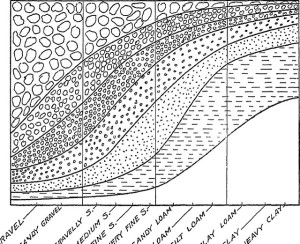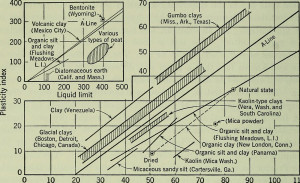 Clay is a fine grained rock that becomes sticky when wet.
Clay is a fine grained rock that becomes sticky when wet.
From there, clearly defining clays is, well, sticky! This is due to the wide variety and uses of clays. Clays have a wide range of characteristics, depending on the chemical makeup of the clay.
Properties of clays are dependent on exactly what minerals are in the clay, but identifying all those minerals can be difficult. It likely will require several different tests to determine exactly what is in a clay sample. But more on those tests in a bit.
Clays are different from soil and sand due to some interesting physical and chemical characteristics:
- Clays have a very high surface area per unit mass. Think of the role that surface area plays in your car radiator — placed where they are, the radiator fins allow for some remarkable heat transfer for such a small mass of metal! This clay characteristic of high area to mass ratio allows for some interesting properties.
- The silicate structures of clay are electrically charged, which can allow for ion exchanges and also cause the clays to interact with water (which is polarized) in ways that are unlike other minerals.
Several billion dollars of clays are sold each year in the U.S. alone, so exploring for new clay deposits is serious business!
Finding a clay deposit
As stated above, clays absorb water and become sticky. It’s hard to get more specific than that, as additional, “deeper” testing is needed to determine what types of clays are in a clay deposit.
Sampling a clay deposit
Here is the process for sampling a clay deposit and sending to a lab:
- Find some dry clay in your deposit that is not contaminated with soil or vegetation.
- Using a shovel, dig and mix the clay together to form a symmetrical, flat pile. The pile could weigh several hundred pounds.
- Use the shovel as a “pencil” and divide that pile into 4 separate equal piles.
- Take one of those quarters and continue dividing that quarter equally, until you get a sample that is roughly 7 pounds (3 kg).
- Double bag the sample, or seal it in a bucket. Send it to your favorite lab for clay evaluation testing!
Testing your clay sample to determine what type(s) of clay it is
- X-ray powder diffraction (XRD) testing — this test pulverizes the clay into a fine power and bounces x-rays off. Then the x-rays are measured, and they will show different reflection angles for various types of clay
- Cation Exchange Capability (CEC) testing — this test determines the ability for your clay to exchange positive cations. This test will help determine what possible uses your clay might have in the market
- Whole rock major oxide analysis — this test uses x-ray fluorescence (XRF) equipment to determine what major oxides (ie SiO2, AlO3) might be present in your clay. This, coupled with a loss on ignition test (around 900 degrees Celsius) can help determine what types of clay you have
- Rehydration Testing — different types of clays absorb moisture at various rates over time. This test takes several days to complete, but is a good analysis for how much moisture your clay sample can take over time. The results can also be compared with other types of clays to find where your clay fits in
Checking the marketability of your sand
 Now, with test results in hand, you have a good idea what type(s) of clay you have in your deposit. From there, it becomes a market-matching game. Much of the game is logistics, so the location of the deposit to transportation and a close buyer of clays will be key.
Now, with test results in hand, you have a good idea what type(s) of clay you have in your deposit. From there, it becomes a market-matching game. Much of the game is logistics, so the location of the deposit to transportation and a close buyer of clays will be key.
For our testing clients, we put together a clay market matrix, showing the clay test results and the various industries — and those industry requirements for clay — that the clay might be marketed to.
We also provide the names, numbers, and e-mail addresses for contacts that could provide more insight to the marketability of your clay deposit.
Further testing of clays (ie testing bentonite)
Once the type of clay is known, further testing can be done if so desired. For instance, if the clay contains a high percentage of montmorillonite clay, it might be used as drilling grade bentonite. Our lab has the capability to test drilling grade bentonite to American Petroleum Institute (API) 13A standards.
Check out our other social media pages!